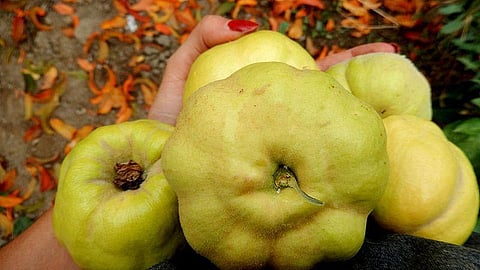

The samovar bubbles in a corner, spreading the sweet fragrance of saffron and cardamom in the air. It is autumn in Kashmir and the sun plays hide and seek from in between the walnut trees—the perfect time to sit out and savour the traditional kahwa. Cookie-shaped kandi kulchas made of flour, butter, sugar and sprinkled with poppy seeds are passed around to be dipped into the tea and relished.
At Afshan Rashid’s farm, Baag Manzuk in Pulwama near Srinagar, plans are afoot to forage for dandelion leaves, also known as hand in Kashmir. The antioxidant and mineral-rich greens are a healthy side dish or one of the main dishes served at a meal. “One of the primary reasons for starting this farm is for our daughter to see where our food comes from,” says Rashid, pointing out that while the apples are for retail purpose, the rest of the vegetables and fruits grown here are to appreciate the delicate connection between nature and food.
Vanshika Bhatia, chef-partner at Gurugram’s ingredient-first vegetarian café OMO, loves exploring new places, ingredients and techniques.
A few months ago, she and her team were in Nagaland and this time, they chose Kashmir for the valley’s rich and diverse culinary heritage. Once back home, she would prepare a menu showcasing the ingredients and cooking techniques they learnt in Kashmir. At Rashid’s farm, Bhatia has extracted natural food colour from cockscomb flower known as mawal, and fried quince, known as bam tchoonth, for a dish with meat. The weather is perfect for an evening stroll near the Lal Chowk market, not far from the Dal Lake.
The autumn season, which extends till November, also known as harud in Kashmir, is when chinar leaves start turning golden-brown. The streets are lined with vegetables of all sorts and colours. There are stalls selling monji gaade (fried fish served with radish chutney), nadir monji (fried lotus stems) and local breads, including the donut-shaped czochworu sprinkled with either sesame or poppy seeds.
Lotus stem also known as nadru, is another popular vegetable. Bulbous garlic and red potatoes jostle for space with vendors selling roasted chestnuts, which make for a delicious snack on nippy October evenings. At another farm near Srinagar with a beautiful view of the Manasbal Lake, Anjum Yousuf welcomes visitors to look around the abundant apple trees.
For people who have only ever bought fruits in supermarkets, there is no bigger delight than plucking a ripe fruit straight from the tree and take a big bite. Yousuf retails organic and preservative-free products such as desi cow ghee, different types of cheese, including the stretchy and dense kalari cheese known locally as maish krej, jams, semolina phirni, quince murabba and traditional Kashmiri waer masala.
With roads being closed during winters and the supply of fresh vegetables cut off, it becomes imperative for residents of the state to sun-dry vegetables and store them for use during the cold months. On window sills and terraces, one can spot small piles of brinjals, cherry tomatoes, gourds and turnips being sun-dried. Once soaked in hot water, these veggies are ready to be used. For Bhatia’s team, this deep dive into the culinary world of Kashmir has only enriched their knowledge. “The vibrant tapestry of Kashmiri cuisine beckons me to explore different techniques and ingredients, each telling a tale of tradition and artistry,” she says, as she breathes in the crackling fresh air.